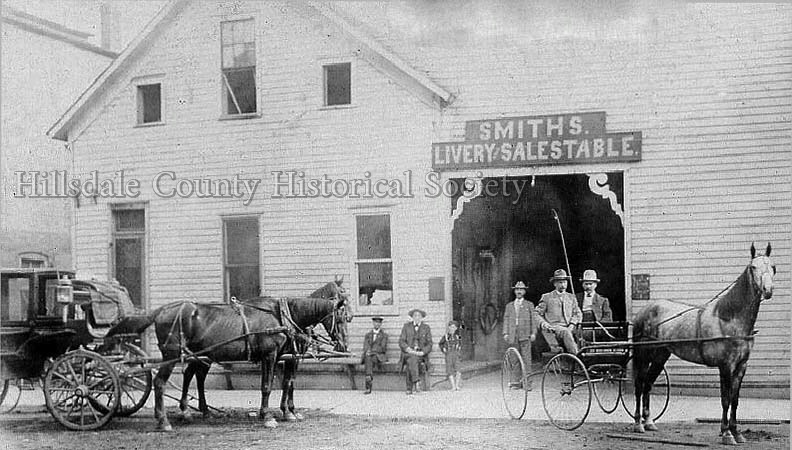Livery Stables
Attending to your horse, your primary mode of transportation, was of vital importance in the days before automobiles. Streets provided hitching posts, and livery stables proliferated as the population of Hillsdale increased. Some people owned a horse or horse and buggy, while others rented when the need arose. Hinkle Brothers on North Broad Street advertised “stylish turnouts at reasonable rates” for those without.
The Smith Hotel offered its patrons livery accommodations along the alley just across Bacon Street. Many hotels also kept their own team and buggy to send to the railroad station when a train came in. Jockeying for position like a line of unruly taxis, the hotel drivers, intent on snagging a paying customer for their employer, competed for the attention of disembarking passengers. The trip back to the hotel was often at breakneck speed to facilitate the capture of as many new hotel patrons as possible.
The combination of a wooden structure and straw in the livery stables made fires a serious possibility. As horses were replaced by automobile horse power, the Pinkham & Wright’s Ford Dealership grew from the ruins of the Peterson Livery on McCollum Street.
Most early communities offered Livery services. The Herring Livery and Feed Stable was one of two Jonesville Village Liveries advertised in the 1874 Hillsdale County Business Directory.
In 1914 the Pankhurst Livery Stable on Broad Street in Hillsdale burned, with the loss of seven horses. Most communities had some sort of livery stable, with the larger ones like Hillsdale and Jonesville having many.
The popularity of the bicycle brought another type of "livery" into play during the same time period.
The fire that burned Peterson’s Livery, on the south side of McCollum east of North Manning Street, eventually made way for the Pinkham and Wright Ford building, now the Midtown Building.
On the night of August 25, 1899, a livery stable behind the Main Street business district in Reading caught fire. The fire spread quickly, and before the night was over twenty-two buildings had been transformed into a pile of rubble.
Between Hillsdale’s railroad tracks and Railroad Street (later Carleton Road) stood the extensive Kinyon Livery. In 1897 Hillsdale City aldermen designated Kinyon and Osborn’s Livery Barn as the voting place for the First Ward.
Carol A. Lackey







